Horse
The right hand with the edge downward, the fingers joined, the thumb recumbent, extended forward. (Dunbar.)
Place the index and middle finger of the right hand astraddle the index finger of the left. [In the original the expression “third” finger is used, but it is ascertained in another connection that the author counts the thumb as the first finger and always means what is generally styled middle finger when he says third. The alteration is made to prevent confusion.] (Wied.) I have described this sign in words to the same effect. (Matthews.) The right arm is raised, and the hand, opened edgewise, with fingers parallel and approximated, is drawn from left to right before the body at the supposed height of the animal. There is no conceivable identity in the execution of this sign and Wied‘s, but his sign for horse is nearly identical with the sign for ride a horse among the Otos. (Boteler.) This sign is still used by the Cheyennes. (Dodge.)
A hand passed across the forehead. (Macgowan.)
Left-hand thumb and forefinger straightened out, held to the level of and in front of the breast; right-hand forefinger separated from the middle finger and thrown across the left hand to imitate the act of bestriding. They appear to have no other conception of a horse, and have thus indicated that they have known it only as an animal to be ridden. (Creel; Cheyenne II.)
Draw the right hand from left to right across the body about the heart, the fingers all closed except the index. This is abbreviated by making a circular sweep of the right open hand from about the left elbow to the front of the body, probably indicating the mane. A Pani sign. (Cheyenne IV.)
Place the first two fingers of the right hand, thumb extended (N 1), downward, astraddle the first two joined and straight fingers of the left hand (T 1), sidewise to the right. Many Sioux Indians use only the forefinger straightened. (Dakota I.) “Horse mounted.”
The first and second fingers extended and separated, remaining fingers and thumb closed; left forefinger extended, horizontal, remaining fingers and thumb closed; place the right-hand fingers astride of the forefinger of the left, and both hands jerked together, up and down, to represent the motion of a horse. (Dakota III.)
The two hands being clinched and near together, palms downward, thumbs against the forefingers, throw them, each alternately, forward and backward about a foot, through an ellipsis two or three times, from about six inches in front of the chest, to imitate the galloping of a horse, or the hands may be held forward and not moved. (Dakota IV.)
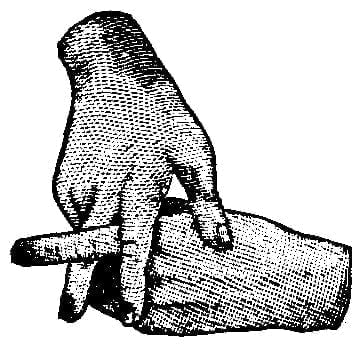
Place the extended and separated index and second fingers of the right hand astraddle of the extended forefinger of the left. Fig. 260. Sometimes all the fingers of the left hand are extended in making this sign, as in Fig. 261, though this may be the result of carelessness. (Dakota VI, VII, VIII; Hidatsa I; Ponka II; Arikara I; PaniI.)

The left hand is before the chest, back upward in the position of an index-hand pointing forward; then the first and second fingers of the right hand only being extended, separated and pointing downward, are set one on each side of the left forefinger, the interdigital space resting on the forefinger. The palm faces downward and backward. This represents a rider astride of a horse. (Mandan and Hidatsa I.)
Close hands, except forefingers, which are curved downward; move them forward in rotation, imitating the fore feet of the horse, and make puffing sound of “Uh, uh”! (Omaha I.) “This sign represents the horse racing off to a safe distance, and puffing as he tosses his head.”
The arm is flexed and the hand extended is brought on a level with the mouth. The hand then assumes the position (W 1), modified by being held edges up and down, palm toward the chest, instead of flat. The arm and hand being held thus about the usual height of a horse are made to pass in an undulating manner across the face or body about one foot distant from contact. The latter movements are to resemble the animal’s gait. (Oto I.) “Height of animal and movement of same.”
The index and second fingers of the right hand are placed astraddle the extended forefinger of the left. (Wyandot I.)
Place the flat right hand, thumb down, edgewise before the right side of the shoulder, pointing toward the right. (Kaiowa I; Comanche III; Apache II; WichitaII.) Fig. 262.
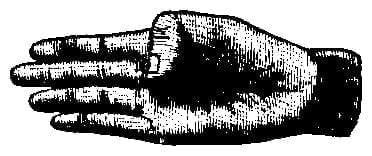
Another: Hold the right hand flat, extended, with fingers joined, the thumb extended upward, then pass the hand at arm’s length before the face from left to right. This is said by the authorities cited below to be also the Caddo sign, and that the other tribes mentioned originally obtained it from that tribe. (Kaiowa I; Comanche I, III; Apache II; Wichita II.) Fig. 263.
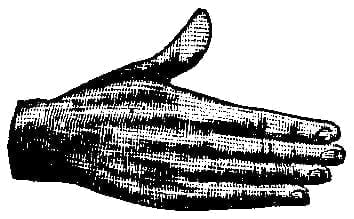
Another: Place the extended and separated index and second fingers astraddle the extended and horizontal forefinger of the left hand. This sign is only used when communicating with uninstructed white men, or with other Indians whose sign for horse is specifically distinct. (Kaiowa I; Comanche III; Apache II; Wichita II.).
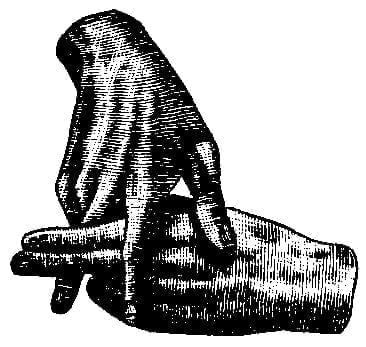
Place the extended index and second fingers of the right hand across the extended first two fingers of the left. Fig. 264. Size of the animal is indicated by passing the right hand, palm down, with fingers loosely separated, forward from the right side, at any height as the case may necessitate, after which the sign for Horse may be made. (Pima and Papago I.)

Place the right hand, palm down, before the right side of the chest; place the tips of the second and third fingers against the ball of the thumb, allowing the index and little fingers to project to represent the ears. Fig. 265. Frequently the middle fingers extend equally with and against the thumb, forming the head of the animal, the ears always being represented by the two outer fingers, viz, the index and little finger. Fig. 266. (Ute I.) A similar sign is reported by Colonel Dodge as used by the Utes.
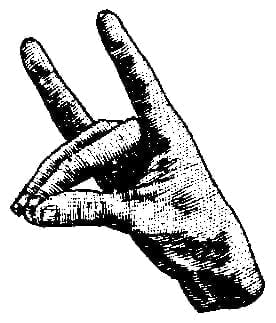
Elevate the right hand, extended, with fingers joined, outer edge toward the ground, in front of the body or right shoulder, and pointing forward, resting the curved thumb against the palmar side of the index. This sign appears also to signify animal generically, being frequently employed as a preliminary sign when denoting other species. (Apache I.)
Deaf-mute natural signs:
Imitate the motion of the elbows of a man on horseback. (Ballard.)
Act in the manner of a driver, holding the lines in his hands and shouting to the horse. (Cross.)
Move the hands several times as if to hold the reins. (Larson.)
Deaf-mute signs:
The French deaf-mutes add to the straddling of the index the motion of a trot. American deaf-mutes indicate the ears by placing two fingers of each hand on each side of the head and moving them backward and forward. This is sometimes followed by straddling the left hand by the fore and middle fingers of the right.
– – , A man on a.
Same sign as for Horse, with the addition of erecting the thumb while making the gesture. (Dodge.)
– -, Bay.
Make the sign for Horse, and then rub the lower part of the cheek back and forth. (Dakota IV.)
– -, Black.
Make the sign for Horse, and then, point to a black object or rub the back of the left hand with the palmar side of the fingers of the right. (Dakota IV.)
– -, Bronco. An untamed horse.
Make the sign To Ride by placing the extended and separated index and second fingers of the right hand astraddle the extended forefinger of the left hand, then with both hands retained in their relative positions move them forward in high arches to show the bucking of the animal. (Ute I.)
– -, Grazing of a.
Make the sign for Horse, then lower the hand and pass it from side to side as if dipping it upon the surface. (Ute I.)
– -, Packing a.
Hold the left hand, pointing forward, palm inward, a foot in front of the chest and lay the opened right hand, pointing forward, first obliquely along the right side of the upper edge of the left hand, then on top, and then obliquely along the left side. (Dakota IV.)
– -, Racing, Fast horse.
The right arm is elevated and bent at right angle before the face; the hand, in position (S 1) modified by being horizontal, palm to the face, is drawn across edgewise in front of the face. The hand is then closed and in position (B) approaches the mouth from which it is opened and closed successively forward several times, finally it is suddenly thrust out in position (W 1) back concave. (Oto and Missouri I.) “Is expressed in the (Oto I) sign for Horse, then the motion for quick running.”
– – Racing.
Extend the two forefingers and after placing them parallel near together in front of the chest, backs upward, push them rapidly forward about a foot. (DakotaIV.)
Place both hands, with the forefingers only extended and pointing forward side by side with the palms down, before the body; then push them alternately backward and forward, in imitation of the movement of horses who are running “neck and neck.” (Ute I; Apache I, II.)
– – , Saddling a.
Hold the left hand as in the sign for Horse, Packing a, and lay the semiflexed right hand across its upper edge two or three times, the ends of the right fingers toward the left. (Dakota IV.)
Place the extended and separated fingers rapidly with a slapping sound astraddle the extended fore and second fingers of the left hand. The sound is produced by the palm of the right hand which comes in contact with the upper surface of the left. (Ute I.) Fig. 267.

– – , Spotted; pied.
Make the sign for Horse, then the sign for Spotted, see page 345. (Dakota IV.)
Kill, Killing
The hands are held with the edge upward, and the right hand strikes the other transversely, as in the act of chopping. This sign seems to be more particularly applicable to convey the idea of death produced by a blow of the tomahawk or war-club. (Long.)
Clinch the hand and strike from above downward. (Wied.) I do not remember this. I have given you the sign for killing with a stroke. (Matthews.) There is an evident similarity in conception and execution between the (Oto and Missouri I) sign and Wied’s. (Boteler.) I have frequently seen this sign made by the Arikara, Gros Ventre, and Mandan Indians at Fort Berthold Agency. (McChesney.) This motion, which maybe more clearly expressed as the downward thrust of a knife held in the clinched hand, is still used by many tribes for the general idea of “kill,” and illustrates the antiquity of the knife as a weapon. Wied does not say whether the clinched hand is thrust downward with the edge or the knuckles forward. The latter is now the almost universal usage among the same tribes from which he is supposed to have taken his list of signs, and indicates the thrust of a knife more decisively than if the fist were moved with the edge in advance. The actual employment of arrow, gun, or club in taking life, is, however, often specified by appropriate gesture.
Smite the sinister palm earthward with the dexter fist sharply, in sign of “going down”; or strike out with the dexter fist toward the ground, meaning to “shut down”; or pass the dexter under the left forefinger, meaning to “go under.” (Burton.)
Right hand cast down. (Macgowan.)
Hold the right fist, palm down, knuckles forward, and make a thrust forward and downward. (Arapaho II; Cheyenne V; Dakota VI, VII, VIII; Hidatsa I; PonkaII; Arikara I; Pani I.) Fig. 268.
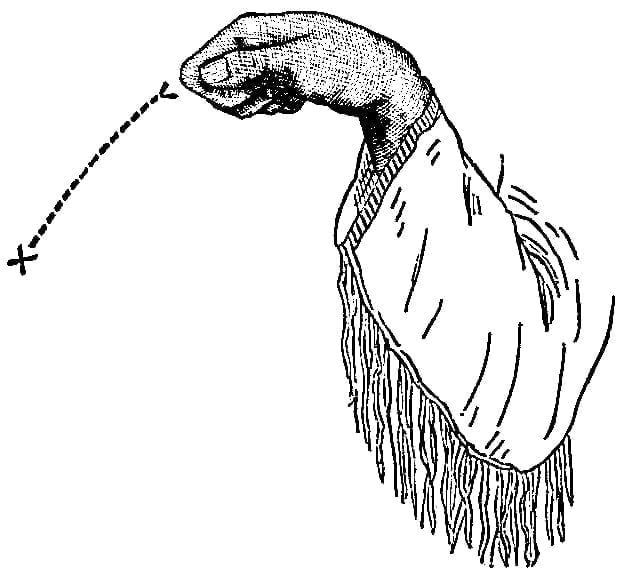
Right hand clinched, thumb lying along the finger tips, elevated to near the shoulder, strike downward and out vaguely in the direction of the object to be killed. The abstract sign for kill is simply to clinch the right hand in the manner described and strike it down and out from the right side. (Cheyenne II.)
Close the right hand, extending the forefinger alone; point toward the breast, then throw from you forward, bringing the hand toward the ground. (Ojibwa V; OmahaI.)
Both hands clinched, with the thumbs resting against the middle joints of the forefingers, hold the left transversely in front of and as high as the breast, then push the right, palm down, quickly over and down in front of the left. (Absaroka I;Shoshoni and Banak I.) “To force under—literally.”
With the dexter fist carried to the front of the body at the right side, strike downward and outward several times, with back of hand upward, thumb toward the left, several times. (Dakota I.) “Strike down.”
With the first and second joints of the fingers of the right hand bent, end of thumb against the middle of the index, palm downward, move the hand energetically forward and downward from a foot in front of the right breast. Striking with a stone—man’s first weapon. (Dakota, IV.)
The left hand, thumb up, back forward, not very rigidly extended, is held before the chest and struck in the palm with the outer edge of the right hand. (Mandan and Hidatsa I.) “To kill with a blow; to deal the death blow.” Fig. 269.

Right hand, fingers open but slightly curved, palm to the left; move downward, describing a curve. (Omaha I.)
Another: Similar to the last, but the index finger is extended, pointing in front of you, the other fingers but half open. (Omaha I.)
Place the flat right hand, palm down, at arm’s length to the right, bring it quickly, horizontally, to the side of the head, then make the sign for Dead. (Ojibwa V; Wyandot I.) “To strike with a club, dead.”
Both hands, in positions (AA), with arms semiflexed toward the body, make the forward rotary sign with the clinched fists as in fighting; the right hand is then raised from the left outward, as clutching a knife with the blade pointing downward and inward toward the left fist; the left fist, being held in situ, is struck now by the right, edgewise as above described, and both suddenly fall together. (Oto and Missouri I.) “To strike down in battle with a knife. Indians seldom disagree or kill another in times of tribal peace.”
Deaf-mute natural signs:
Strike a blow in the air with the clinched fist, and then incline the head to one side, and lower the open hand, palm upward. (Ballard.)
Strike the other hand with the fist, or point a gun, and, having shot, suddenly point to your breast with the finger, and hold your head sidewise on the hand. (Cross.)
Use the closed hand as if to strike, and then move back the head with the eyes shut and the mouth opened. (Hasenstab.)
Put the head down over the breast, and then move down the stretched hand along the neck. (Larson.)
Turkish sign:
Draw finger across the throat like cutting with a knife. (Barnum.)
– – In battle, To.
Make the sign for Battle by placing both hands at the height of the breast, palms facing, the left forward from the left shoulder, the right outward and forward from the right, fingers pointing up and spread, move them alternately toward and from one another; then strike the back of the fingers of the right hand into the slightly curved palm of the left, immediately afterward throwing the right outward and downward toward the right. (Ute I.) “Killed and falling over.”
– – You; I will kill you.
Direct the right hand toward the offender and spring the finger from the thumb, as in the act of sprinkling water. (Long.) The conception is perhaps “causing blood to flow,” or, perhaps, “sputtering away the life,” though there is a strong similarity to the motion used for the discharge of a gun or arrow.
Remarks and illustrations connected with the signs for kill appear on pages 377 and 378, supra.
– -, to, with a knife.
Clinch the right hand and strike forcibly toward the ground before the breast from the height of the face. (Ute I.) “Appears to have originated when flint knives were still used.”
